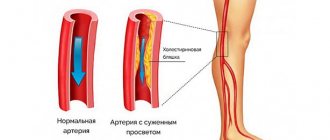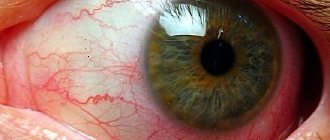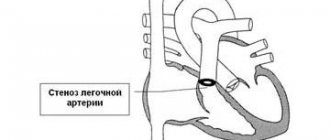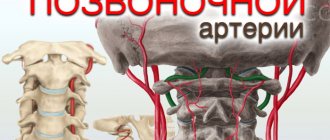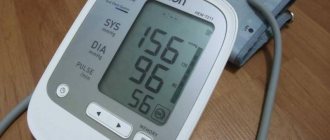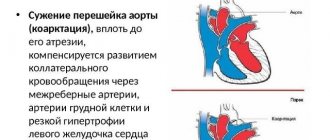Conditions for the occurrence of narrowing of veins and arteries
The causes of vasoconstriction are very diverse. They depend on the type of vessel, external and internal factors, and the duration of their exposure.
External reasons
Arteries have a pronounced muscular layer, so they more often react with spasm to unfavorable factors. During spasm, small arteries narrow temporarily, but frequent repetition can lead to loss of the ability to relax and become stable.
Contributing factors are:
- smoking,
- stressful situations,
- alcohol consumption,
- hypothermia.
A similar external effect on the arteries is observed:
- with the development of vegetative-vascular dystonia;
- in the initial stages of hypertension and ischemic disease;
- with frostbite of the extremities;
- with Raynaud's syndrome.
Longer-term narrowing of arterial vessels from external factors is observed with mechanical compression:
- during severe injuries (long-term compartment syndrome);
- tumor growth near blood vessels;
- the pressing action of the bone tissue of the spinous processes of the spine;
- prolonged incorrect use of a tourniquet to stop bleeding (this is why first aid requires placing a note indicating the time of application).
Internal reasons
Internal causes of vasoconstriction include:
- atherosclerotic damage to the wall - between the middle and inner membranes of arteries of the muscular-elastic type, a low-density fraction of lipoproteins is deposited with the formation of plaques, over time they are supplemented with calcium salts, the lumen of the vessel loses its diameter;
- inflammatory changes (vasculitis, arteritis) - swelling of the walls reduces blood permeability;
- endarteritis - an unclear allergic reaction from the intima of the arteries of the legs and arms, leading to complete obliteration of the vessel;
- congenital pathology (aortic stenosis);
- thrombosis and embolism - play an important role in the development of pathology of the brain and heart;
- metabolic disorders in diabetes mellitus, thyrotoxicosis, obesity.
Prevention
Prevention of this disease is aimed primarily at preventing heart and vascular diseases and includes:
- proper nutrition with a low fat content (see Foods that are good for the heart and blood vessels: what to eat to keep our “engine” healthy for many years);
- daily drinking regime;
- active lifestyle (sports, walks, active entertainment);
- timely treatment of chronic diseases;
- annual medical examination.
This instruction will not completely protect against the risk of developing pathology, but will reduce it to a minimum.
The prognosis for life and recovery directly depends on how early the stenosis was detected. Therefore, at the first signs of the development of heart failure, it is recommended to consult a cardiologist for examination. Timely treatment will allow you to avoid the development of serious complications and surgical interventions, limiting yourself to conservative therapy.
When do veins narrow?
The venous system is more prone to lose tone, but there is a pathology that leads to a persistent gradual loss of the diameter of the venous capillaries, and then the cessation of blood supply. We are talking about cirrhosis of the liver. All blood flowing from the tissues necessarily passes through this organ. With chronic inflammation of the lobules of liver cells (hepatocytes) and replacement of the interlobular space with scar tissue, the venules narrow. Then the blood flow through them completely stops. Problems arise in the area of the portal vein. Due to its sharp narrowing, hypertension and stagnation occur in the underlying sections, and overload of “excess” into the veins of the esophagus.
On the right is the liver of a patient with cirrhosis, there are no vessels between the compacted lobules
Thrombophlebitis (inflammation + thrombosis) cannot be excluded as a cause. In diseases that cause a decrease in blood flow velocity (stagnation), the process of parietal thrombus formation is activated. The spread of infection from chronic foci increases the narrowing of the affected area of the vein.
Symptoms of circulatory disorders due to altered vascular lumen depend on the specific location of the affected area. Let's look at the manifestations of the most significant diseases.
Blocked blood vessels
The main causes of blockage of the heart vessels are constant stress, a sedentary lifestyle, bad habits, and poor diet. When, as a result of such negative factors, harmful cholesterol begins to accumulate in the body, it affects not only the blood vessels of the brain, but the heart and other systems in the body.
Another factor affecting the blood vessels of the heart is diabetes, which harms the blood vessels, their elasticity and strength.
Atherosclerosis of the vessels of the legs occurs as a result of a violation of lipid metabolic processes, when a large number of cholesterol plaques accumulate on the walls of the vessels of the lower extremities. When this phenomenon develops, the lumens of blood vessels narrow, blood flow is disrupted, and the supply of oxygen and nutrients to the body’s tissues decreases. Against the background of atherosclerosis of the lower extremities, a more severe disease develops - coronary heart disease .
The main symptoms of blockage of blood vessels in the legs are pain in the calf muscles at a normal pace of walking, an increase in such sensations when walking up the stairs or during long walks. Sometimes lameness occurs and dry gangrene develops in the most atherosclerotic areas of the legs. Blockage of blood vessels in the legs also manifests itself as a disease such as endarteritis , in which tissue necrosis develops due to circulatory disorders and insufficiency. The main signs of this disease are increased fatigue of the legs, cramps, acute attacks of aches and periodic lameness.
Varicose veins are one of the most common diseases today, which develops against the background of blockage of blood vessels. When the disease develops and intensifies, the veins lose their elasticity, and dense formations appear inside them, visible to the naked eye and palpable with the fingers. Pathology can develop very, very slowly, over several years. During this period, symptoms accumulate and intensify: the veins dilate and this is already visible upon visual examination, heaviness and increased fatigue appear in the legs, a burning sensation is felt, cramps and swelling appear.
After diagnosis, the doctor prescribes therapy based on the disease and the individual characteristics of the patient’s body. Alirocumab or Pentosan Polysulfate SP 54 are often prescribed.
General recommendations for the treatment of vascular blockage include an active lifestyle, changes in diet, and giving up bad habits.
In the most severe cases, surgical intervention is performed and, using various medical techniques, the vessels are cleared of the accumulation of cholesterol plaques.
Clinical manifestations of impaired blood supply to the brain
Signs of cerebral insufficiency are caused by narrowing of the carotid and vertebral arteries, which carry blood to the brain.
For adults, the main importance is given to:
- atherosclerosis;
- cervical osteochondrosis;
- congenital pathology of vertebral vessels;
- hypertension;
- thromboembolic complications.
The disease can take a long-term chronic course or occur suddenly in the form of a stroke.
For the child, the most important are:
- mother's condition during pregnancy;
- birth injuries;
- previous vasculitis due to childhood infections;
- congenital pathology of the heart and blood vessels.
If you faint, a stroke cannot be ruled out.
In acute cases, concern:
- severe headaches;
- dizziness to the point of loss of consciousness;
- noise in ears;
- impaired vision;
- decrease or disappearance of sensitivity and movements in the limbs;
- impaired speech.
Chronic deficiency occurs gradually, all symptoms begin with irritability, insomnia, and impaired attention. Then memory loss, fatigue, headaches, and insomnia increase. Further narrowing of blood vessels leads to a change in personality, the inability to contact others, and movement disorders.
Characteristic symptoms
Vasoconstriction, the symptoms of which increase in a person over time, depends on which organ is experiencing a deficiency of oxygen and nutrients associated with impaired blood supply.
Poor blood supply to the brain
If there is a narrowing of the vessels carrying blood to the brain, the patient will experience the following symptoms:
- Chronic condition: all symptoms appear gradually. At the initial stage of vasoconstriction, a person notices irritability, insomnia, and impaired attention. If no measures are taken, the signs of vasoconstriction increase, and they manifest themselves as constant headaches, absent-mindedness and memory problems. A significant disruption of the blood supply to the brain leads to problems with coordination and mental health of the patient.
- Acute condition: the symptoms of the pathology are pronounced. Severe headache, loss of consciousness, tinnitus, sudden loss of vision, nausea, problems with speech - all this can occur with a sharp narrowing of the vessel and acute disruption of the blood supply to the brain.
Important! If there are symptoms of a sudden disruption of the blood supply to the brain, a person needs emergency medical care!
In the cervical region
If the vessels (arteries) of the neck narrow, then this phenomenon often occurs with osteochondrosis of the cervical spine , and this manifests itself:
- headache and a feeling of squeezing in the temporal region;
- dizziness when turning the head suddenly;
- cases of loss of consciousness;
- nausea, less often vomiting.
Heart vessels
Heart vessels (coronary arteries) are subject to narrowing when exposed to negative factors. With atherosclerosis of the vessels that supply blood to the heart, conditions such as heart rhythm disturbances, pressing and squeezing pain behind the sternum .
If the pain is intense and prolonged, and the patient himself feels severe weakness, then all this indicates a myocardial infarction.
Narrowing of the aorta
Narrowing of the aorta is manifested by a decrease in the lumen of its mouth, which is a congenital defect .
Every second case of aortic narrowing is combined with pathology of the mitral valve of the heart.
This condition develops against the background of rheumatic endocarditis and atherosclerosis.
Narrowing of the aorta has the following symptoms:
- deterioration in general health;
- pain in the heart area;
- a feeling of strong tremors when the heart muscle contracts.
Vessels of the legs
The following symptoms indicate impaired blood supply to the legs, which occurs against the background of vasoconstriction:
- a feeling of heaviness in the limbs, especially after prolonged exercise;
- numbness of the feet and legs;
- increased sweating of the feet;
- cramps in the calf area;
- pronounced vascular “pattern” of the limbs;
- the appearance of venous lumps.
With advanced pathology of the blood vessels of the legs, trophic ulcers, cracking of the skin and even gangrene can occur.
Clinical features for narrowing of arteries in the neck
Atherosclerosis of the carotid artery is considered the first manifestation of the disease. It is detected during Doppler sonography in individuals who do not yet have symptoms. Osteochondrosis affects the processes of the vertebrae in the cervicothoracic region, which compress the vertebral artery. The patient is concerned about:
- headaches in the temples, back of the head, forehead;
- feeling of "pressure";
- connection of well-being with turning and tilting the head to the side;
- dizziness, darkening of the eyes;
- possible loss of consciousness;
- nausea, vomiting.
Less often they complain of numbness of the tongue and hands.
Neck vasoconstriction
Cholesterol reduces the diameter of the carotid artery, resulting in impaired blood flow.
When the vascular system of the neck changes, the lumen of the arteries supplying blood to the brain narrows. Because of this, the carotid arteries may change pathologically. In this case, the veins of the neck remain in the same state.
You can read why the carotid artery is called that from this article
The symptoms of problems with the cervical vessels are similar to those that occur when there is poor circulation in the brain area.
This feature often does not manifest itself and the patient learns that he had narrowed neck vessels only after a stroke.
To diagnose the disease in a timely manner, you need to pay attention to the following signs:
- Darkening in the eyes;
- Dizziness;
- “Dots” before the eyes;
- Noise in ears;
- Weakness of the upper and lower extremities.
Normal and narrowed arteries
What manifestations suggest a narrowing of the blood vessels of the heart?
The vessels of the heart or coronary arteries are very sensitive to factors contributing to spasm. And the local location of atherosclerotic plaques in them seriously changes the blood supply to the myocardium. “Oxygen starvation” manifests itself:
- attacks of angina pectoris;
- arrhythmia.
The pain is pressing or squeezing in nature, located behind the sternum or on the left, radiating to the left jaw, shoulder blade, arm, lasting up to 30 minutes.
With more intense and prolonged pain, severe weakness of the patient, and a feeling of arrhythmia, one should think about acute myocardial infarction. In this case, the narrowing of the vessel leads to an area of tissue necrosis.
Slow blood flow through the narrowed area promotes the formation of a blood clot
Treatment of atherosclerosis
HMG-CoA reductase inhibitors (statins) are used to treat atherosclerosis. They influence cholesterol metabolism, helping to dissolve existing plaques and reduce cholesterol and lipids in the blood, and also prevent the formation of new atherosclerotic deposits.
Treatment of atherosclerosis often eliminates pathological narrowing
In clinical studies, the use of atorvastatin and rosuvastatin showed significant clearance of aa. coronaria from cholesterol plaques. Which leads to a decrease in cardiovascular failure and a decrease in the risk of myocardial infarction.
Surgery
Modern surgery has in its arsenal three types of operations for narrowing of the coronary vessels:
- Endarterectomy (removal of blood clot);
- Vascular bypass surgery;
- Vascular stenting.
Endarterectomy
This operation involves surgical removal of a blood clot from the lumen of a coronary vessel. One of its varieties is atherectomy (removal of cholesterol plaque due to atherosclerosis).
Both of these interventions are now almost never used, since their implementation is not only associated with high risks, but also often leads to recurrent thrombus formation. Therefore, doctors prefer other types of operations.
Stenting
This operation can be performed either planned to prevent myocardial infarction, or urgently when it develops to eliminate ischemia and restore blood supply to the heart muscle.
This surgical intervention consists of installing a stent in the affected vessel. This is done through the femoral artery, so stenting is a minimally invasive procedure that does not require large incisions and general anesthesia. With the help of a guide, the stent is delivered to its destination - the affected artery.
It is installed in it and then straightened out. The design of this device allows the vessel to be maintained in a dilated state to its normal diameter, which ensures adequate blood flow.
Stenting mechanism
The entire course of the procedure and the correct positioning of the stent are controlled by X-ray equipment, so the operation requires special equipment in the operating room.
You can learn more about this type of surgery from the video in this article.
Bypass surgery
Coronary artery bypass surgery involves providing a bypass path for blood flow and disconnecting the affected artery from it. A shunt is created using the patient's own vein or artery, which allows blood flow to the heart muscle to be restored, bypassing the blocked vessel.
The operation diagram is shown in the photo below:
CABG
This operation is very traumatic, as it requires the use of a heart-lung machine and opening the chest. The rehabilitation period is usually long and difficult, and complications often arise.
Symptoms of insufficient blood supply to the legs
Signs of narrowing of the arteries of the lower extremities are detected in obliterating endarteritis, vascular atherosclerosis, and Leriche syndrome.
Concerned:
- pain in the legs, first only when walking, then at rest;
- symptom of “intermittent claudication”, after stopping the pain disappears;
- numbness and chilliness of the feet;
- increased sweating;
- cramps in the calf muscles;
- in severe stages, trophic disorders - ulcers, non-healing cracks in the feet, gangrene.
Treatment
Depending on the degree of narrowing of the lumen and the cause that caused it, treatment of stenosis of the heart vessels is carried out using conservative therapy or surgical intervention.
Drug treatment can have good effects only in the early stages of the development of heart failure. If symptoms are severe, surgery is required.
Table. Degrees of heart failure.
| Degree | Symptoms |
| Lightweight | The patient does not experience any symptoms with normal physical activity. Increased loads cause slight shortness of breath, weakness, palpitations, chest discomfort |
| Average | Prolonged physical activity causes shortness of breath, tachycardia, chest pain |
| Heavy | At rest, the patient does not show any complaints. But with normal physical activity, symptoms of heart failure occur |
| Very heavy | Symptoms of heart failure appear even at rest and gradually increase |
Drug treatment
In order to improve blood supply to the heart, reduce symptoms of heart failure and prevent the development of myocardial infarction during drug treatment of aa stenosis. coronaria is used:
- vasodilators;
- anticoagulants;
- diuretics.
If the cause of the disease is atherosclerosis, additional medications are prescribed to help dissolve cholesterol plaques and prevent the formation of new ones.
What does narrowing of the fundus arteries indicate?
Also read:Spasm of blood vessels in the head
The fundus arteries undergo the same changes as others. They are considered a “mirror” of the state of cerebral circulation. The degree of narrowing is influenced by the following external and internal reasons:
- bad light;
- eye strain when working at a computer;
- watching TV for a long time;
- increased blood pressure.
The patient complains of:
- blurred vision;
- headache;
- throbbing pain in the eyeballs.
The ophthalmoscopy procedure allows the ophthalmologist to examine the arteries and veins of the fundus of the eye.
How to treat narrowed blood vessels
Treatment for vasoconstriction depends on the underlying causes. If there is a connection with external factors, their complete exclusion is necessary. Any temporary spasm carries the possibility of turning into permanent obstruction. Therefore, you should take the recommendations for regimen and diet seriously:
- stop sitting at night in front of the computer and TV;
- normalize sleep;
- pay more attention to active recreation, walks;
- learn to relieve stress;
- establish nutrition according to the requirements of an anti-atherosclerotic diet (do not indulge in coffee, spicy foods, fatty meat dishes, add enough fruits, vegetables, and dairy products to the diet);
- choose feasible exercises and do morning physical exercises.
You should treat your illness with medications only as prescribed by your doctor.
If necessary, the following are prescribed:
- cholesterol-lowering agents;
- antispasmodics;
- medications that stimulate collateral (auxiliary) blood circulation;
- drugs that strengthen the vascular wall;
- means to reduce tissue oxygen demand;
- vitamin complexes;
- physiotherapeutic supportive treatment.
The diagram shows connecting “tubes” - these are the auxiliary vessels at work
Disturbed metabolic processes in tissues are treated with antioxidants and nootropics.
Depending on the severity of the patient’s condition and after determining the degree of narrowing of the afferent vessels, angiosurgeons choose surgical treatment. Methods include:
- replacement of a damaged vessel with an artificial analogue;
- bypass installation operation;
- removal of a blood clot from a large artery;
- installation of stents to expand the spasmodic area.
Possible reasons
Narrowing of the heart vessels can develop for various reasons.
These include:
- atherosclerosis;
- obesity;
- metabolic diseases;
- endocrine diseases;
- elderly age;
- smoking;
- sedentary lifestyle;
- congenital malformations;
- vasculitis and other diseases of the blood and blood vessels.
Depending on the mechanism of development, narrowing of the coronary arteries may occur due to vasospasm, blockage by a blood clot or cholesterol plaque.
The coronary arteries must ensure uninterrupted flow of blood into the myocardium
Is it possible to be treated with traditional methods?
You cannot straighten a narrowed vessel with folk remedies. You should not collect and test on yourself numerous “tips” for cleaning and getting rid of atherosclerosis.
Using a combination of garlic, lemon and honey is more of a dietary recommendation. It has a good effect on the immune system, so it is always useful. The product will help in the recovery period after stress, injury or infection. But it is impossible to “dissolve plaques” at the current level.
Medicines will help delay further narrowing. People's advice can be tried against the background of their application.


